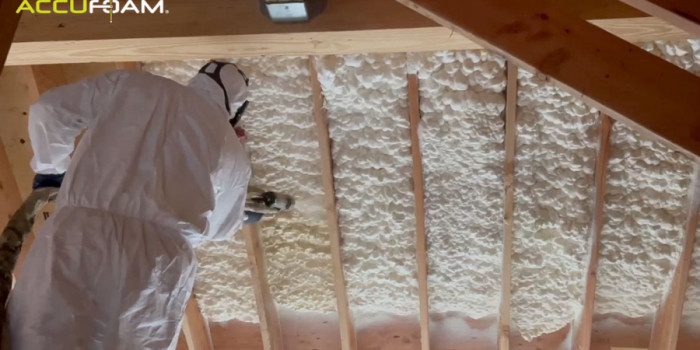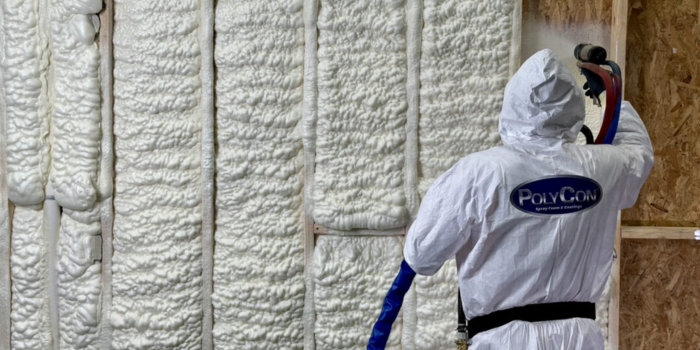Foam & Sound


JUPITER, FL – March 5, 2018 – Sometimes, when you are talking to customers and prospects, they may ask about a benefit of spray foam. It may be on a subject that you know you can help with, but you may not be exactly sure how it works, what to do to make it work or what to say. One of the benefits that falls into this category for most of us is sound attenuation, sound mitigation, or sound proofing.
So, how does sound work?
Sound waves are transmitted by vibrations that move through the air and through solid objects, like building materials. When a sound moves from one room to another or from the outside to the inside, the sound wave has either moved through the air or through the walls, floors, and ceilings.
There are three ways to reduce sound—blocking, absorbing, and dampening—and the most effective technique depends on the type of noise.
For sounds moving from space to space or outside to inside, like street traffic, your neighbor’s music next door or your kid’s television upstairs, sound blockers are most important. Sound blockers are used in walls, floors, and ceilings to block, stop, and redirect sound waves. One of the most common sound blockers in construction is gypsum wall board. It’s hard and dense, and lowers sound transmission. Also, both open-cell and closed-cell spray foam work as sound blockers because they are air barriers and help block airborne sound transmission. This is why you may have heard a great story about how your customer no longer hears the barking dogs in the neighborhood or the airplanes when they fly overhead.
However, blocking only helps with noises traveling from one area to another. What about improving the sound quality inside a room? Now you need sound absorbers—they soak up, trap, and dissipate the sound waves. Music studios and home theaters are surrounded by sound absorbers prefer open-cell spray foam. Open-cell spray foam is an excellent sound absorber as it is light, porous and soft, and closed-cell spray foam is not a sound absorber because it is higher density and has a tendency to reflect sound more than absorbing it, creating echo and reverb.
Finally, sound dampening uses a combination of materials for blocking and absorbing to force sound waves to travel through multiple materials with different densities, ultimately resulting in reduced vibrations through the structure. The highest tested wall assemblies such as staggered 2x4-inch studs on a 2x6-inch base plate use these techniques, where they decouple building materials and only partially filling the wall cavity with open-cell spray foam insulation.

When it comes to measuring sound attenuation performance, two metrics are most often used: STC, which stands for Sound Transmissions Class, and NRC, which stands for Noise Reduction Coefficient.
STC ratings measure how much sound a material or an assembly can block, and the higher the STC rating, the better the assembly and the less sound that transmits. Typically, an STC rating of 36 would minimize most normal talking from room to room, while a rating of 60 would make most sounds inaudible. As you read above, this primarily applies to sound transmission from one side of an assembly to another, such as through a wall, floor, or ceiling. STC ratings can be critical for some designs where sound transmission is important and when confidentiality and privacy are paramount, like multi-family living, lawyer offices, or human resource departments.
And NRC ratings measure how much sound a material or assembly absorbs. The NRC rating for a material ranges from 0 to 1, and the higher the NRC rating, the better the material absorbs sounds. Another way to look at NRC is as a percentage—an NRC of 0.75 means that 75 percent of the sound waves that come in contact with the test material or assembly are absorbed and are not reflected back within the space.
RELATED Getting Ahead of Winter: The November/December 2017 Issue of Spray Foam Magazine Is Here , July/August 2017 Spray Foam Magazine Heats Up The Summer , Icynene Europe Announces Suite of New Spray Foam Product Innovations, Honeywell Discusses the Fundamentals of Blowing Agents
With this added knowledge, what does sound attenuation mean for us in the spray foam insulation industry?
It means opportunity. It means providing another ancillary benefit for our customers. Remember, both open-cell and closed-cell spray foam are air barriers and because we use them to air seal buildings, they both will reduce airborne noise. This helps mitigate noise that travels through assemblies from one area to another, like music, television, and conversations.
However, for sound attenuation purposes overall, open-cell spray foam insulation is better than closed-cell spray foam because open-cell spray foam does an excellent job of absorbing sound waves, whereas closed-cell spray foam is more likely to create an echo chamber resulting in a reverb effect.
Now, while open-cell spray foam is a better option than closed-cell spray foam, these are only building materials and there are a few other design parameters that will improve the sound attenuation of your assemblies:
Minimize the connection from one side of an assembly to the other side. For example, use staggered studs or resilient channel.
Do not fill the cavity with insulation because the air gap between the insulation and wallboard minimizes the vibrational contact through the wall.
An additional layer of gypsum will help. When you add density to the wall, the sound performance gets better.
Finally, sound attenuation can be a bit subjective, because what is “quiet” to you, may not be quiet enough for me. So when your customers want or need documented sound attenuation benefits, it is best to consult your SPF manufacturer to find out what assemblies they have tested, what documentation they have, and how they might be able to help.
Disqus website name not provided.









































